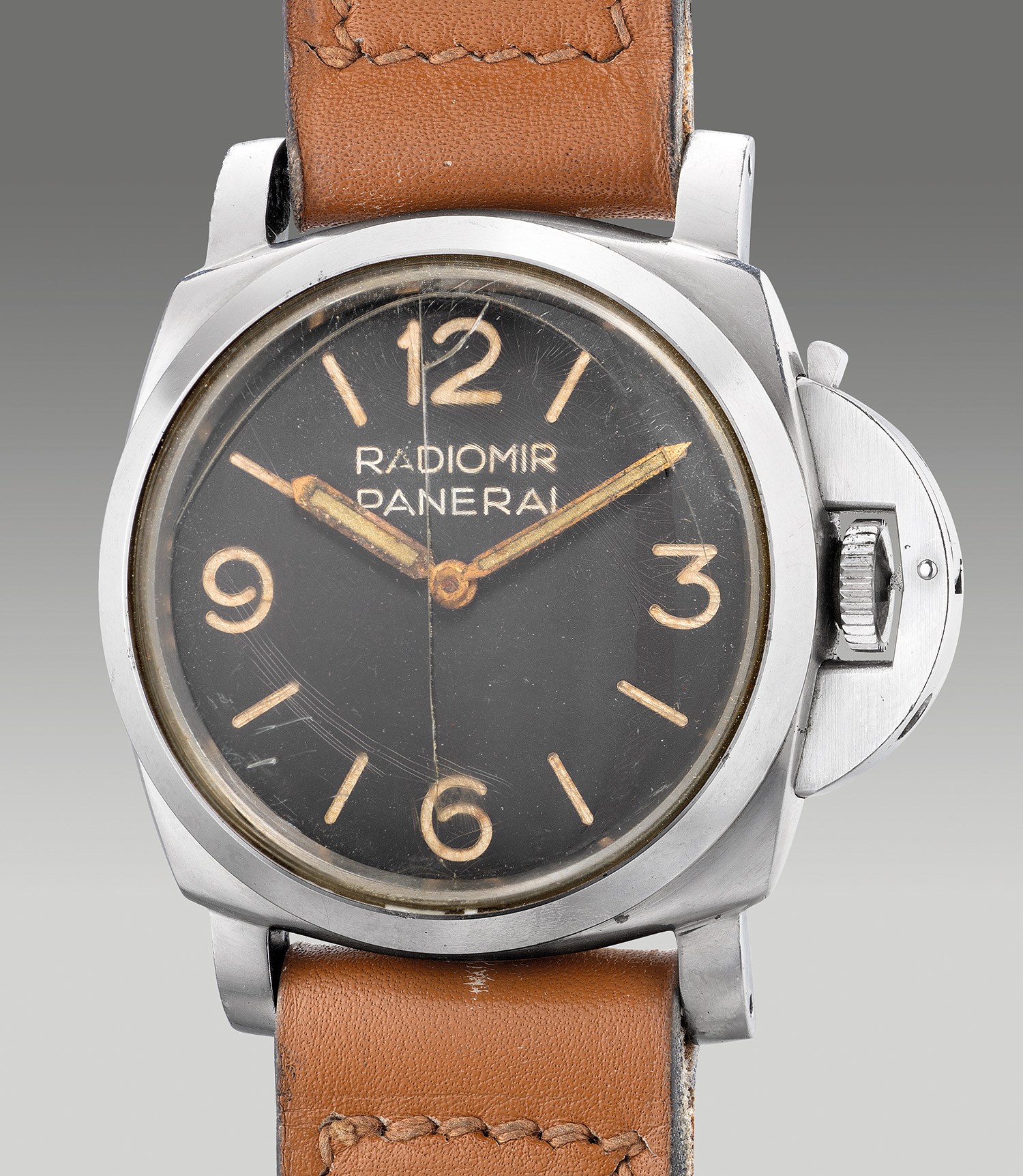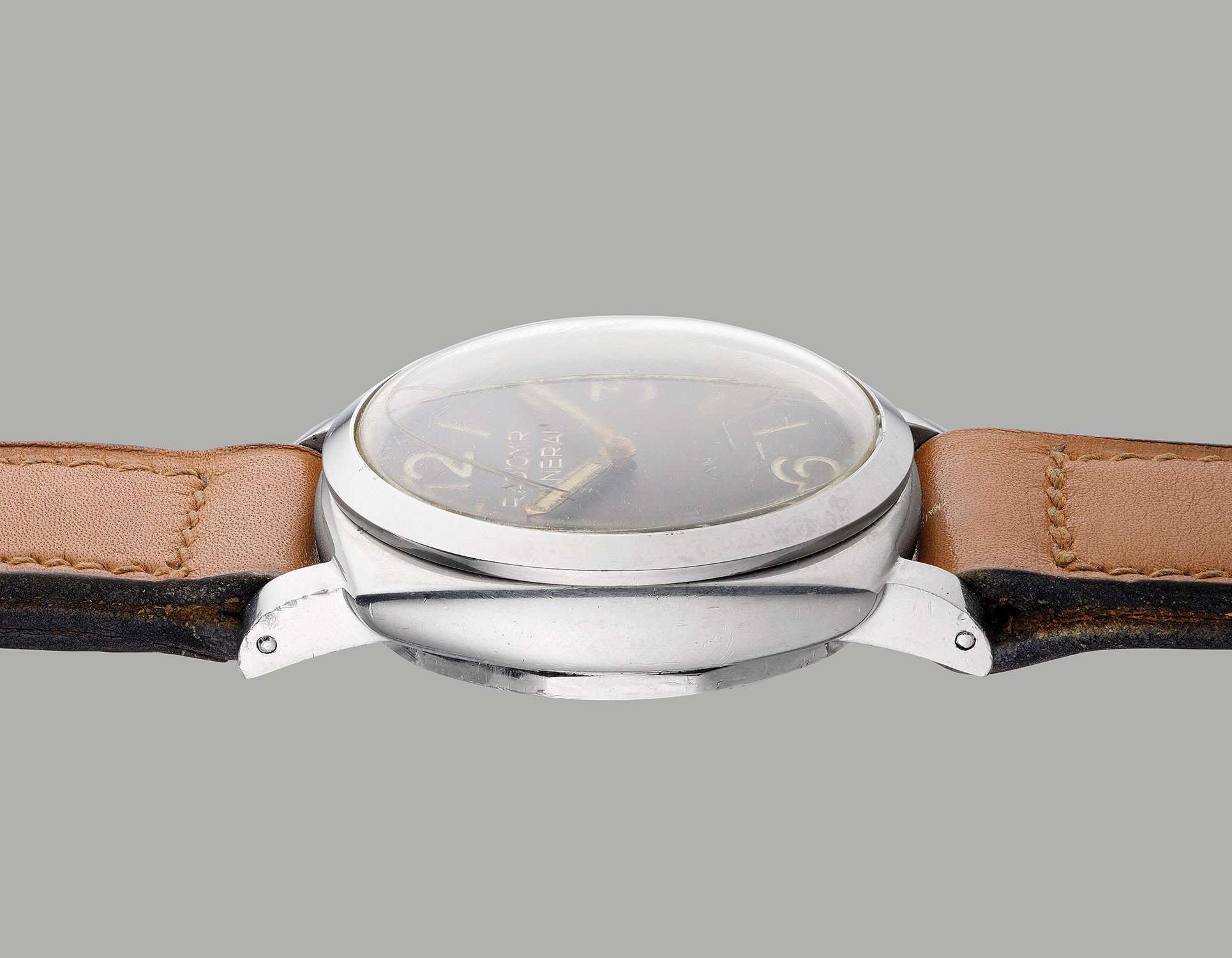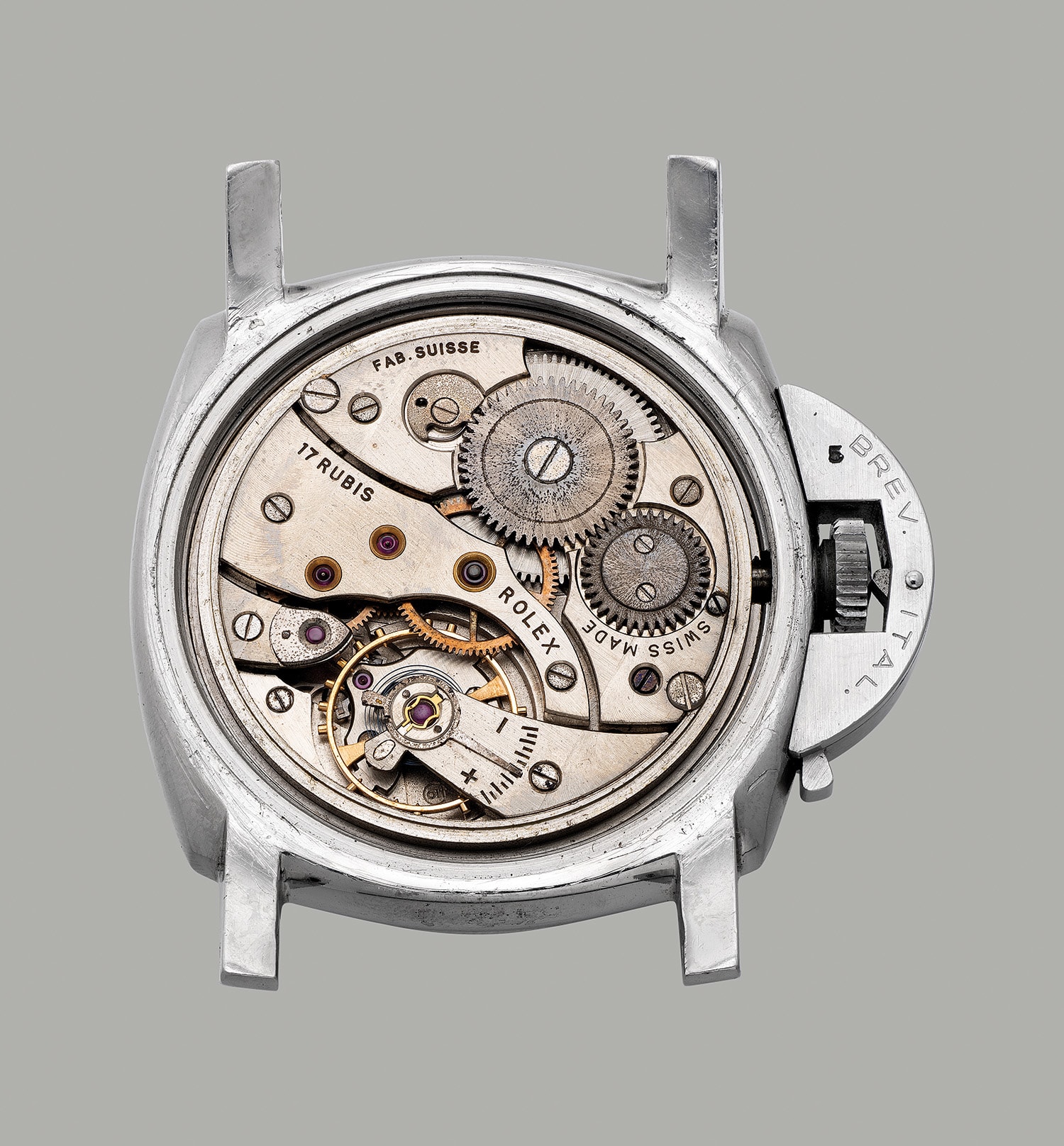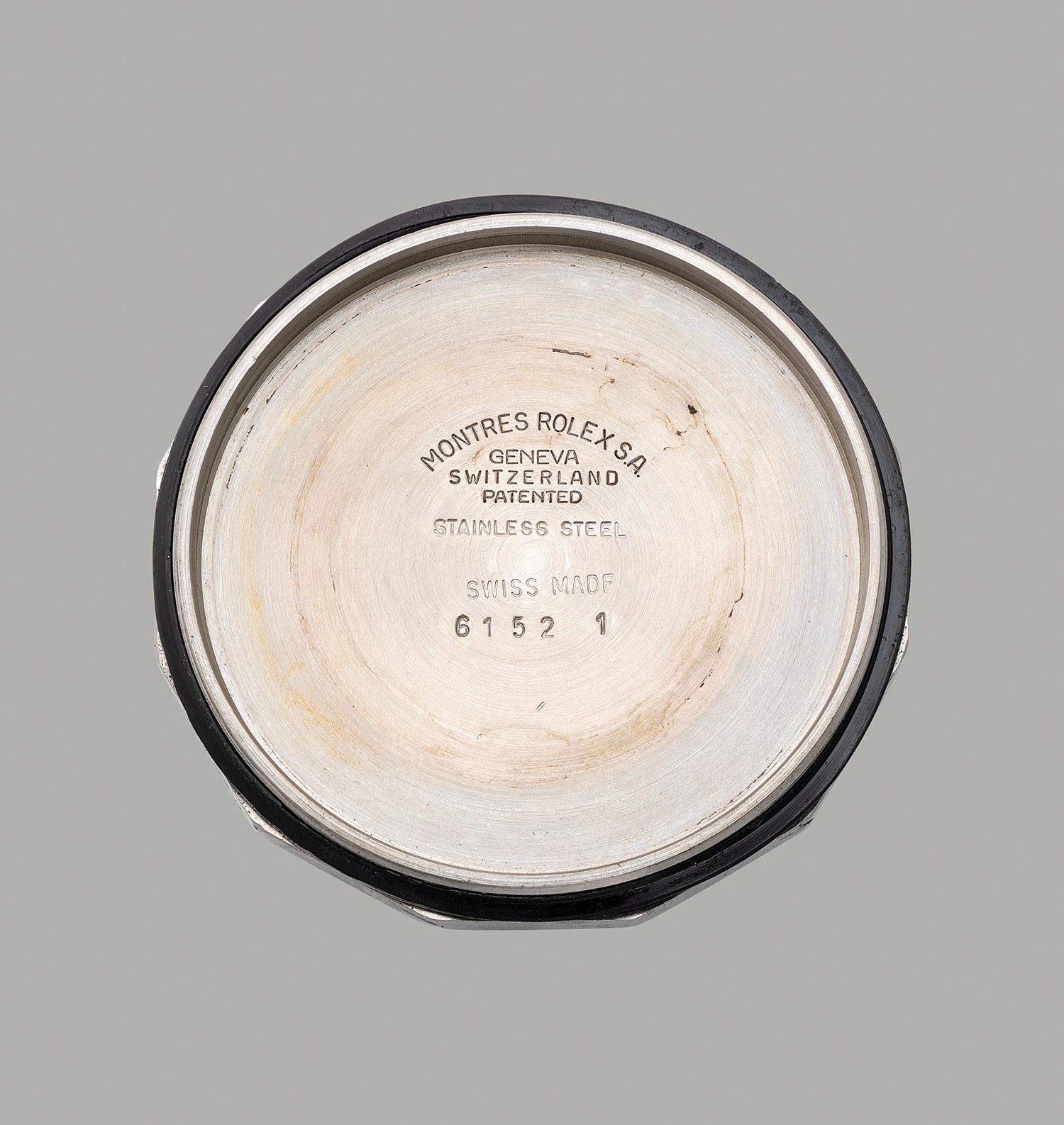











820
Panerai
Ref. 6152-1
Radiomir
A very rare and oversized stainless steel cushion-shaped diver’s wristwatch with black dial, delivered to the Carabinieri Sommozzatori
Full-Cataloguing
Ref. 6152-1 was manufactured by Rolex in 1955. All of the 500 pieces made featured signature Rolex Big Crowns (8mm) known from the Rolex “King Sub” Ref. 6200. The first examples delivered to the Italian Navy were equipped with radium-based Radiomir Panerai dials. Around 1958, Panerai started heavily modifying Ref. 6152-1 by removing the Big Crown and adding their patented crown-protecting device. To do so, the cases had to be machined to provide a flat seat for the large half-moon shaped crown guard. Later in the mid 1960s, Panerai developed their tritium-based luminous compound named Luminor. All watches delivered to the Italian Navy and other customers such as the Carabinieri Sommozzatori thereafter were equipped with Luminor dials. The ones for the Italian Navy were engraved with Marina Militare, the other customers received Luminor Panerai engraved dials.
Around the same time, the Marina Militare started replacing all highly radioactive Radiomir dials on previously supplied watches with the latest Luminor dials. In the same breath, all watches also received new, slightly thinner hands painted with tritium-based luminous compound.
Only a handful of these early Ref. 6152-1 watches supplied between 1955 and the mid 1960s retained the original Radiomir dials. In most cases, this occurred because the watches were gifted to retired divers and were never serviced afterwards. C.C. No 1 is such a rare piece. In addition, it is also the only known Carabinieri watch to feature a Radiomir dial.
C.C. No 1 shows clear signs of wear and tear but is still in great shape for its 60 plus years. The Rolex reference and case numbers between the lugs are still crisp. The C.C. No 1 engravings on the outside of the caseback are perfectly visible. The inside of the caseback features the typical Rolex stamps from the era in addition to the reference number 6152/1. The iconic crown-protecting device is engraved with Brev. Ital. which refers to the Italian patent. Most Panerai crown guards found on Ref. 6152-1 are stamped with numbers between 1 and 10. The significance of these numbers is unknown.
The dial of this watch is a typical Radiomir dial from the late 1950s that developed a lovely cream-coloured patina on all markers and numerals. The skeletonized hands aged beautifully with slight traces of surface oxydation. A Geiger counter measurement shows high levels of radioactivity.
A special feature of this watch would be the original plexi crystal with its distinct and highly sought-after spider-web-like craze but unfortunately, it cracked in some areas. For this reason, Phillips will include a replacement crystal.
The Cortébert-made Rolex 618 caliber with 17 jewels, overcoiled Breguet hairspring and Incacloc shock protection is in nice condition with slightly oxydized crown and ratched wheels. The watch comes with its original soft-iron cover which is supposed to shield the movement from strong magnetic fields emitted by limpet mines, etc.
As of today, only 12 of the 30 Carabinieri watches have surfaced and only the present one features a Radiomir Panerai dial.
C.C. No 1 124'682 Radiomir Panerai (The present example)
C.C. No 2 124'XXX Dial unknown
C.C. No 3 124'898 Luminor Panerai (Commander Gianfranco Allegretti, Co-founder Carabinieri Subacquei)
C.C. No 6 124'XXX Luminor Panerai
C.C. 7 124'XXX Luminor Panerai
C.C. 8 124'880 Luminor Panerai
C.C. No 15 124'646 Luminor Panerai
C.C. No 17 124'XXX Luminor Panerai
C.C. No 20 124'801 Luminor Panerai
C.C. No 22 124'754 Luminor Panerai
C.C. No 24 124'XXX Luminor Panerai
C.C. No 28 124'762 Luminor Panerai
Carabinieri Sommozzatori
The Italian Carabinieri are a national military force, primarily carrying out domestic policing duties. The name Carabinieri originates from carabine, a long-barreled firearm whose barrel is shorter than that of a standard rifle or musket. The carbine was originally developed for cavalry troopers as it was easier to handle. Established in 1814 as Corpo dei Carabinieri Reali (Royal Carabinieri Corps), the force was renamed in Arma dei Carabinieri after the second world war when Italy became a republic. As the fourth branch of the Italian Armed Forces, the Carabinieri are under the authority of the Ministry of Defense.
Following the pioneering work of Italian Navy frogmen during World War 2 (Decima Flottiglia MAS, Gruppo Gamma), the Carabinieri established their own underwater unit named Carabinieri Sommozzatori (Carabinieri Divers) in 1953. The main purpose of the unit was to deal with crime scenes at the bottom of water bodies such as the sea, lakes, rivers and wells but also to carry out rescue missions in case of floods, etc. Initially performed with the help Italian Navy divers, the Carabinieri soon became more and more self-suficient. In 1955, the two initial bases in Genoa and Napoli were merged into one headquarter in Genoa. As a result of the great success of the unit, their services were expanded in 1964 and new local bases were set up in a number of major coastal cities. Around the same time, the headquarter in Genoa became the national training centre. Prior to this, all Carabinieri frogmen received their basic training at the ComSubIn base in the Varignano Fortress in Porto Venere, La Spezia. In October 1971, the headquarter in Genoa changed its name from Centro Carabinieri Sommozzatori to Centro Carabinieri Subacquei.
The Carabinieri divers performed several notable missions. In 1965, they heped locate a midget submarine that went missing in the Lago Maggiore near Locarno, Switzerland. Another notable intervention was the heroic rescue of several crew members from the British merchant ship “SS London Valour” in 1970. The large vessel had been driven aground by strong winds just outside the harbour of Genoa. When in late 1971 a Hercules C-130 of the Royal Air Force crashed into the sea near Livorno, Italy, Carabinieri divers helped revover the remains of all 46 passengers and six crew members.
G. Panerai & Figlio supplied the Carabinieri Sommozzatori with a total of around 30 watches. All of them featured special engravings on their casebacks. C.C. for Carabineri, followed by the individual watch number. Since the watches were delivered in small batches, there are some slight variations in the way the casebacks were engraved.
PHILLIPS would like to thank Perezcope for the research and archival images for the present lot.
The Carabinieri Sommozzatori were not the only customer outside the Italian Navy to receive these watches. Other law enforcement agencies such as the Guardia di Finanza (G.F) or the Polizia di Stato (P.S.) created their own diving units and bought their own equipment from G. Panerai & Figlio. Their watches featured similar engravings.
Panerai
Italian | 1860Known for its robust designs and large case sizes, Officine Panerai was established in 1860 by Giovanni Panerai in Florence, Italy. Around 1900, Giovanni's grandson Guido Panerai took over, and Panerai became the supplier to the Regia Marina — the Royal Italian Navy. After supplying the navy with high-precision instruments for a number of years, Officine Panerai created Radiomir, a radium-based powder that gives luminosity to the dials of sighting instruments and devices. By 1936, the Royal Italian Navy approached Panerai again with the request to design a watch resistant to extreme underwater conditions. The watch they created became known as the "Radiomir".
Panerai's watches made during the early twentieth century era were comprised of cases designed and manufactured by Rolex SA, with Cortébert, a Swiss manufacturer, supplying the majority of their movements. The most recognizable designs from the firm are the Radiomir and Luminor. To date, vintage models from the first half of the 1900s, such as the reference 3646 and 6152 models, remain the most desirable among collectors.